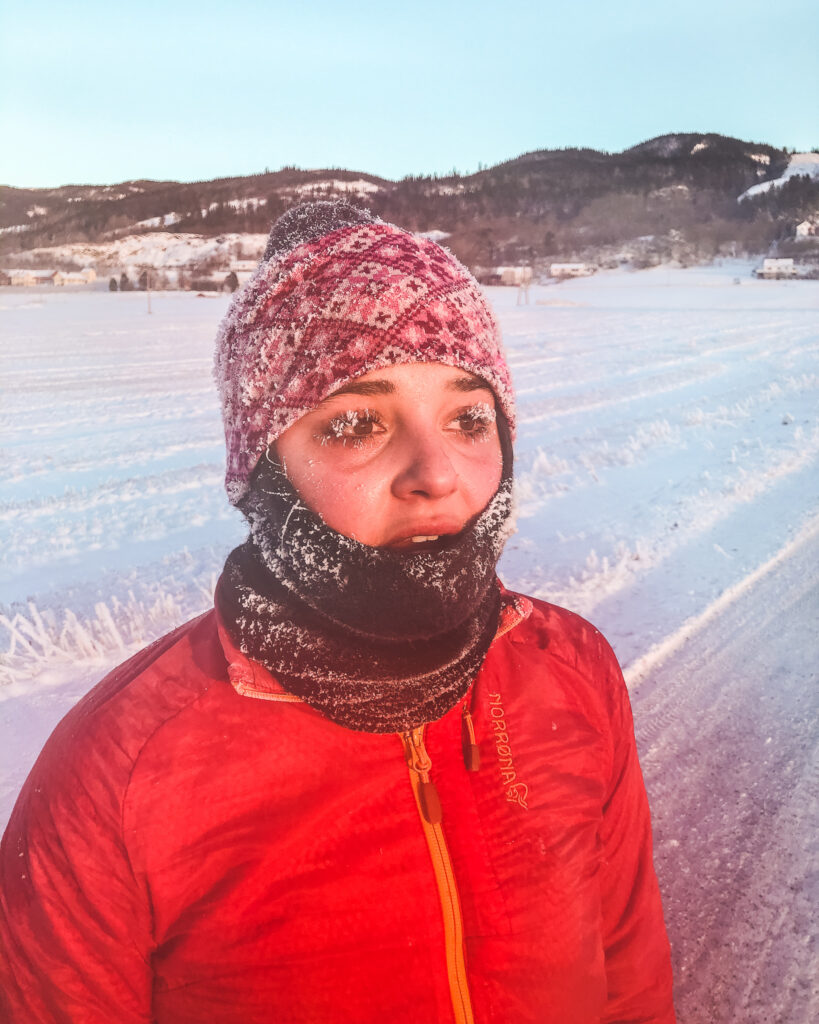It's winter in Norway. A perfectly normal day in February gives a temperature of -10 degrees Celsius (14 Fahrenheit)
What challenges does this give you who love to run?
(10 min read) Running in the snow or on the ice requires a slight refinement in technique. Generally speaking, you will want to take shorter, lighter strides or you will be slipping and sliding all over the place. If you concentrate on engaging your core as you run, this should give you the stability you need to tackle the icy patches. You will find that you are working different muscle groups and areas of your legs and hips when you run in the snow, so make sure not to overdo it the first time!
The most common injuries and how to avoid them:
Table of content
Leg, knee, hip
Runners knee, jumpers knee, various hip ailments, osteomyelitis and Achilles ailments are all injuries that occur frequently during the winter among avid runners. It is easy to put many of the injuries in connection with driving conditions, as this places great demands on winter footwear, running steps and muscles.
Achilles pain
Achilles pain can be associated with running in loose snow and slush conditions. Poor grip gives us an extra “pull” in the Achilles tendon every time you put your foot down. (And if you slip, it puts even more strain on the calves and Achilles. Spiked shoes can be helpful on ice, but do not provide good enough grip when there is a lot of snow and slush.
Tip: Run calmly as far as possible under such conditions. Spiked shoes are probably the best choice to avoid this type of ailment when the surface is demanding. Remember that spiked shoes can give a wrong load when you run, compared to what you are used to from the summer’s running trips.
Osteomyelitis and jumpers knee
Osteomyelitis and jumpers knee can be associated with hard surfaces (ice) and frequent use of shoes with poor cushioning. When the ice settles in the ground, all running becomes as if you are running on asphalt. In addition, spiked shoes are often tougher on the legs than shoes without spikes. Thus, the probability of developing osteomyelitis and jumpers knee becomes extra high in winter. Jumpers knee is an inflammation of the mucous sacs that lie like dampers around the knee. When these are pressed hard together, an inflammation often occurs.
Tip: Vary the surface. Find shoes with extra cushioning. Do not use psiked shoes if not necessary.
Hip ailments and runners' knee
Hip ailments and runners’ knee: A theory as to why this type of ailment occurs most frequently in the winter, may be about running steps. When we run in the winter, we run stiffer. It makes muscles tight and we are not as soft in the hips.
Tip: Spiked shoes should be worn when it is slippery outside. Try to relax as much as possible in the muscles that you strictly do not use to a great extent when you run. Seek out a treadmill when you are going to run fast, and when the conditions are extra demanding outside.
Fall injuries
In addition to the injuries mentioned here, fall injuries are typical in the winter. Well-spiked shoes are an alternative, but these can also provide a false sense of security. In addition to the mentioned damages that spiked shoes can trigger.
Tip: Run calmly and carefully. Wear spiked shoes, but do not overdo it. Adjust the amount of exercise so that the body gets used to the shoes and the lining.
Not always easy to be wise
Everyone who runs knows that a change in running style or surface is a potential possibility of injury. Therefore, it is important as always to start calmly. Increase when you think you are ready for it.
Tip: Vary as much as possible, as it will make the load on the body more even. Winter is a great time to increase weight training.
Running in cold weather
It is not dangerous to run in cold weather. Dress well and feel free to exercise. But be careful with intensive training when it gets too cold. If you have asthma or a mild cold, you must of course consider the conditions when the temperatures are very low or the air pollution is high. Cold weather causes dry mucous membranes, and can cause respiratory problems.
Adjust speed according to conditions
Adjust the speed according to the conditions, use footwear that you trust to get a good grip, vary the running with a treadmill and alternative training, and get the best out of the winter training.
Remember that even if you have found a pair of shoes with good grip, these may not fit your feet. Therefore, be critical when buying shoes. The shoes should give a good grip at the same time as they are comfortable on your feet.
Higher running frequency and the right shoes are my best advice for safer running in the winter.
It’s not about running faster. But if you cut the steps instead of stretching them completely, you increase the frequency so that the running becomes more stable. On slippery ice, it is important to have your foot well under you, and not in front of you, when it lands. For the sake of balance, you should land on the whole foot, but with shorter steps it is easier to get forefoot running.
If you run steadily throughout the winter, it is easier to avoid injuries that you can easily pull on when you start running again in the spring. Are you running on treadmill you do not use the calf muscles, you just move your legs and thus you will face problems as soon as you change from the treadmill to a path in the woods.
The biggest challenge with winter running is slippery roads and that you feel you are slipping for every step. When you slip a little when you step off is a nasty feeling. You can avoid this with spikes under the shoes.
Maintain the physical fitness
If you have not run during the winter, you will have to spend some time in the spring to get your legs used to tough running sessions again.
DO NOT LAND ON THE HEEL: Running on snow and slippery surfaces is a challenge for the body, and winter running requires a relatively good running technique if one is to get the maximum benefit from the sessions. It is especially important to avoid landing on the heel. Therefore, it is wise to shorten the step.
RELAX IN THE UPPER BODY: See if you can relax in the shoulders and arms. Run with easy steps. Get up and have a proud attitude. Get your hips up and forward. Focus on running technique, and trust that the shoes you are wearing will take care of the footing on the challenging surface.
FOCUS ON THE FRONT PART OF THE FOOT: Try to land on the front part of the foot with the leg just below the body.
RUN WITH SHORT STEPS: If it is very slippery, it is smart to shorten the stride length and increase the pace. But avoid tripping on your toes.
ARM PENDANT: Arms are kept slightly bent and should be moved in the direction of speed, not sideways. Let your arms determine the rhythm of the run. Take advantage of the terrain and especially the slopes. Downhill running is and will be very effective in terms of building better shape. Vary the training.
If you train three times a week or more, I would train two sessions with a little speed and a higher heart rate, and a slightly longer, calm ride. As the weather can be challenging in the winter, it is easy to run into “habits” or get injured. Try not to run tense, but rather be a little careful with the speed. But if there are good days with bare beards, just run at full speed.
Why you are injured?
Some runners have a significantly higher risk of injury than others. Dutch researchers have identified the most vulnerable runner types.
Up to 70 percent of all runners will sooner or later be injured. But the injuries do not affect all types of runners, and for some the risk is far higher than for others. It shows a large Dutch meta-study where the researchers have worked through over 400 different studies of running injuries
The runners who are most exposed, regardless of gender, are those who have been injured before. According to the researchers, the reason is partly that many people tend to start training too early after an injury, and partly that many start too hard when they start training again.
But even more important is that it shows that many have too weak running muscles and can not tolerate the training they are exposed to. Therefore, the researchers recommend supplementary and injury prevention strength training.
According to the study, there is a difference between which men and which women have the greatest risk of being injured. Among men, it is often beginners and people who train a lot, who are at risk. For women, it turns out that the surface is very important, for example if they run a lot on hard surfaces.
Male runners who are often injured
- Runners who have been injured before. Starts too fast and too hard after injury. The injury is usually due to weak muscles.
- Runners who have run for less than two years. It takes a long time for bones and tendon tissue to get used to the load.
- Runners over 50. Muscles and tendons become stiffer with age, and the ability to recover is weakened.
- Overweight runners. The heavier you are, the greater the strain on your knees and feet for each step you take.
- Runners who run more than 60 km every week. The greater the amount of exercise, the more stress for the body. Those who run a lot are usually more ambitious and thus less willing to take the body’s signals seriously.
Sources and additional reading

What is a lifetime, really?
Twenty good years? A good friend of mine once said while walking in the mountains of Gran Canaria.“Knut, we have twenty good years left. Use

How to protect yourself from your PTSD, when the world is on fire
(It is war. And it is mine. ) The headlines that meet me today are about the war in Ukraine. Alarms going off, people fleeing,

The thin film of civilization
The thin film of civilization This picture are taken on Lesvos. Her husband and baby drowned on the way over from Turkey. This is a
